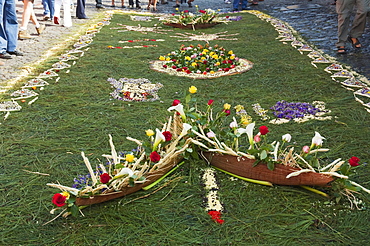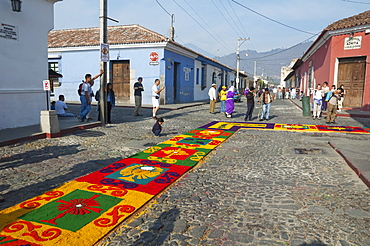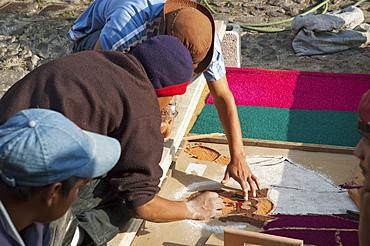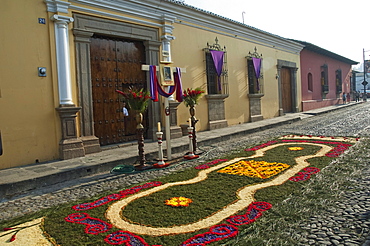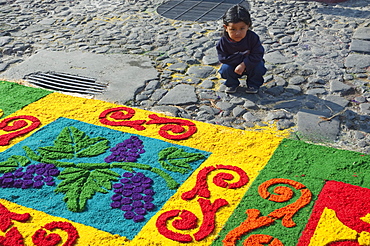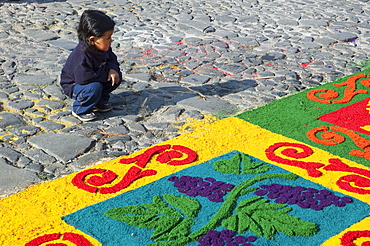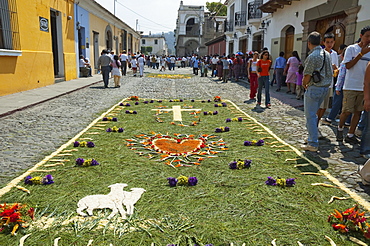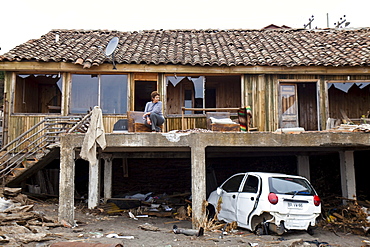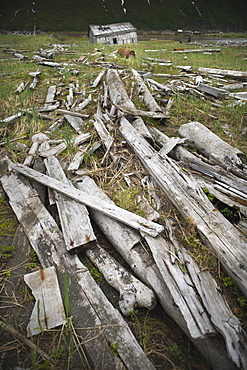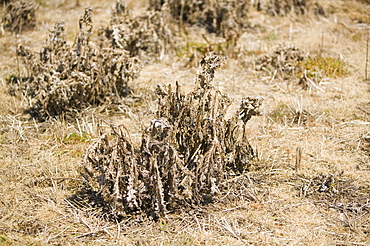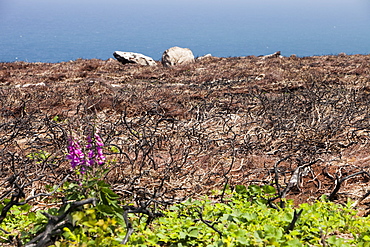Recent searches
Loading...
1116-27193 - Carpet made of pine needles & flowers along the Good Friday processional route. Carpet-making is thought of as a sacrificial act, as the elaborate detail and time that go into the carpet making is a way for people to give something of themselves in memory of the crucifixion of Jesus. These carpets last on average 2 hours before they are destroyed by the many feet that march over them during a procession in Antigua Guatemala., Sacatepuquez, Guatemala
1116-10692 - Remains of the old Hazar bazaar destroyed by the Taliban in Bamiyan, Bamian Province, Afghanistan
1116-10689 - Panoramic view of Bamiyan and the escarpment with hundreds of caves and the niche that contained the Small Buddha statue destroyed by the Taliban in 2001, Bamian Province, Afghanistan
1116-27188 - Carpet made of pine needles, flowers, sand & sawdust along the Good Friday processional route. Carpet-making is thought of as a sacrificial act, as the elaborate detail and time that go into the carpet making is a way for people to give something of themselves in memory of the crucifixion of Jesus. These carpets last on average 2 hours before they are destroyed by the many feet that march over them during a procession in Antigua Guatemala., Sacatepuquez, Guatemala
1116-27187 - People making a carpet of sand & sawdust with the image of Jesus along the Good Friday processional route. Carpet-making is thought of as a sacrificial act, as the elaborate detail and time that go into the carpet making is a way for people to give something of themselves in memory of the crucifixion of Jesus. These carpets last on average 2 hours before they are destroyed by the many feet that march over them during a procession in Antigua Guatemala., Sacatepuquez, Guatemala
1116-27284 - People working on a carpet made of sand & sawdust along the Good Friday processional route. Carpet-making is thought of as a sacrificial act, as the elaborate detail and time that go into the carpet making is a way for people to give something of themselves in memory of the crucifixion of Jesus. These carpets last on average 2 hours before they are destroyed by the many feet that march over them during a procession in Antigua Guatemala., Sacatepuquez, Guatemala
1116-26446 - Remains of the San Juan Parangaricutiro Church destroyed by the Paricutin Volcano eruption from 1943 to 1952, Michoacun, Mexico
1116-27186 - Carpet made of pine needles, flowers, sand & sawdust along the Good Friday processional route. Carpet-making is thought of as a sacrificial act, as the elaborate detail and time that go into the carpet making is a way for people to give something of themselves in memory of the crucifixion of Jesus. These carpets last on average 2 hours before they are destroyed by the many feet that march over them during a procession in Antigua Guatemala., Sacatepuquez, Guatemala
1116-27190 - Girl by a carpet made of sand & sawdust along the Good Friday processional route. Carpet-making is thought of as a sacrificial act, as the elaborate detail and time that go into the carpet making is a way for people to give something of themselves in memory of the crucifixion of Jesus. These carpets last on average 2 hours before they are destroyed by the many feet that march over them during a procession in Antigua Guatemala., Sacatepuquez, Guatemala
1116-27196 - People making a carpet made of sand & sawdust along the Good Friday processional route. Carpet-making is thought of as a sacrificial act, as the elaborate detail and time that go into the carpet making is a way for people to give something of themselves in memory of the crucifixion of Jesus. These carpets last on average 2 hours before they are destroyed by the many feet that march over them during a procession in Antigua Guatemala., Sacatepuquez, Guatemala
1116-27199 - People making a carpet made of flower & pine needles along the Good Friday processional route. Carpet-making is thought of as a sacrificial act, as the elaborate detail and time that go into the carpet making is a way for people to give something of themselves in memory of the crucifixion of Jesus. These carpets last on average 2 hours before they are destroyed by the many feet that march over them during a procession in Antigua Guatemala., Sacatepuquez, Guatemala
1116-27189 - Girl by a carpet made of sand & sawdust along the Good Friday processional route. Carpet-making is thought of as a sacrificial act, as the elaborate detail and time that go into the carpet making is a way for people to give something of themselves in memory of the crucifixion of Jesus. These carpets last on average 2 hours before they are destroyed by the many feet that march over them during a procession in Antigua Guatemala., Sacatepuquez, Guatemala
1116-27201 - People making a carpet made of flower & pine needles along the Good Friday processional route. Carpet-making is thought of as a sacrificial act, as the elaborate detail and time that go into the carpet making is a way for people to give something of themselves in memory of the crucifixion of Jesus. These carpets last on average 2 hours before they are destroyed by the many feet that march over them during a procession in Antigua Guatemala., Sacatepuquez, Guatemala
1116-929 - Tankardstown Mine, Copper Coast, Near Bunmahon, County Waterford, Ireland
1116-9296 - Ancient Dolmen Ruins; Ballinskelligs, County Kerry, Ireland
1116-9305 - Ancient Poulnabrone Dolmen; County Clare, Ireland
1116-9302 - Ancient Poulnabrone Dolmen; County Clare, Ireland
857-69057 - A man rifles through the debris of what was his home, destroyed by an earthquake in Yinghua Village, China.
857-68904 - Liu Chunnan, 22, with her 10 day old baby in a camp for people whose homes were destroyed in the Sichuan earthquake. 5/15/2008
857-55787 - Houses are destroyed in Curanipe, Chile after an 8.8 earthquake and subsequent tsunami struck this coastal town.
857-55788 - Houses are destroyed in Curanipe, Chile after an 8.8 earthquake and subsequent tsunami struck this coastal town.
857-55786 - Houses are destroyed in Curanipe, Chile after an 8.8 earthquake and subsequent tsunami struck this coastal town.
857-55792 - Houses are destroyed in Curanipe, Chile after an 8.8 earthquake and subsequent tsunami struck this coastal town.
857-34003 - A truck drives over a makeshift bridge supported by ruined tanks on the road north of the Salang Tunnel in Baghlan province, August 31, 2002. High in the mountains of the Hindu Kush, the road was destroyed several years ago by a flood from raging mountain rivers. The road was improved by the Soviets after their 1979 invasion of Afghanistan, and was a crucial link for troops and supplies coming from the Soviet Union. The mountain road is in terrible condition, and its repair is crucially important for the reconstruction of the country
857-33933 - Women in burqas flock like doves to the entrance of the main mosque at the Blue Mosque complex, Mazar-i-Sharif, Balkh Province, September 23, 2002. Wednesday mornings are reserved for women to come and worship at the mosque.Elaborate tilework and decorated spires adorn the mosque, also known as the Shrine of Hazrat Ali (Hazrat Ali was the son-in-law of the prophet Mohammed), who is believed to be buried here. The shrine, of particular importance for Afghanistan's Shi'ite Muslims, was first built in the 12th century, destroyed by Genghis Khan, and rebuilt in 1481. The current mosque, considered by some to be one of the most beautiful in Central Asia, is a modern restoration.
857-33936 - A man feeds white doves at dawn in front of the Blue Mosque, Mazar-i-Sharif, Balkh Province. Hundreds of doves, who are fed by worshippers and tended by special workers, live around the mosque, and it is thought that the place is so holy that a grey or brown dove will turn white if it lands on the Mosque. The mosque is also known as the Shrine of Hazrat Ali (Hazrat Ali was the son-in-law of the prophet Mohammed), who is believed to be buried here. The shrine, of particular importance for Afghanistan's Shi'ite Muslims, was first built in the 12th century, destroyed by Genghis Khan, and rebuilt in 1481. The current mosque, considered by some to be one of the most beautiful in Central Asia, is a modern restoration.
857-32777 - A pier that was destroyed in Colonial Beach, VA in Hurricane Isobel on Sept. 16, 2003. On the pier was an off shore riverboat gambling operation.
857-34048 - Two school girls hurry across a street at dawn in Kabul, Afghanistan. Since the fall of the Taliban, a record number of girls have returned to school throughout Afghanistan. Much of Kabul was destroyed in the mid 1990's (1992-1996) in factional fighting between rival mujahideen commanders for control of the capital after the Soviet's withdrawal, and now Afghans are re-building their lives and business
857-33993 - Striking Mongol features distinguish the face of a woman and her child (who is blind) living in the ruins of the Qala-i-Dokthar (Daughter's Castle), outside of the town of Bamiyan, August 30, 2002. Most of the old town was destroyed and up to 20,000 people of the region might have perished when Bamiyan fell to the Taliban in 2001. Bamiyan Valley is located in the Hazarajat at the edge of the Koh-i-Baba range , the end of the Hindu Kush. Bamiyan was a prosperous Buddhist kingdom on the ancient Silk Road until the 10th century, when the region was converted to Islam; in the 12th century, it was destroyed by Ghengis Khan. Most of the people of this region are of the Hazara tribe, and are Shi'a Moslems who have been persecuted for centuries by many of the Pashtun rulers of Afghanistan, who are from the Sunni sect. They most recently suffered at the hand of the Taliban, who tried for years to ethnically cleanse the region of its Shi'a people.
857-34049 - An Afghan man sits on his wooden cart and drinks tea at dawn from a street tea stall in central Kabul. With the first respite from war in nearly two decades, Kabulis are busy re-building their lives and business amongst the ruins, and the streets are busy with markets, tea stalls, trucks, etc. Much of Kabul was destroyed in the mid 1990's (1992-1996) in factional fighting between rival mujahideen commanders for control of the capital after the Soviet's withdrawal.
857-33992 - Striking Mongol features distinguish the face of Hamir Mohammed, his daughter and grandson (who is blind), all living in the ruins of the Qala-i-Dokthar (Daughter's Castle), outside of the town of Bamiyan, August 30, 2002. Most of the old town was destroyed and up to 20,000 people of the region might have perished when Bamiyan fell to the Taliban in 2001. Bamiyan Valley is located in the Hazarajat at the edge of the Koh-i-Baba range , the end of the Hindu Kush. Bamiyan was a prosperous Buddhist kingdom on the ancient Silk Road until the 10th century, when the region was converted to Islam; in the 12th century, it was destroyed by Ghengis Khan. Most of the people of this region are of the Hazara tribe, and are Shi'a Moslems who have been persecuted for centuries by many of the Pashtun rulers of Afghanistan, who are from the Sunni sect. They most recently suffered at the hand of the Taliban, who tried for years to ethnically cleanse the region of its Shi'a people
857-33935 - Tajik women proudly pose with their children, burqa's thrown back, in front of the main entrance to the Blue Mosque, Mazar-i-Sharif, Balkh Province. Wednesday mornings are reserved for women to come and worship at the mosque. Elaborate tilework and decorated spires adorn the mosque, also known as the Shrine of Hazrat Ali (Hazrat Ali was the son-in-law of the prophet Mohammed), who is believed to be buried here. The shrine, of particular importance for Afghanistan's Shi'ite Muslims, was first built in the 12th century, destroyed by Genghis Khan, and rebuilt in 1481. The current mosque, considered by some to be one of the most beautiful in Central Asia, is a modern restoration.
857-33991 - A farmer with his donkey loaded with forage walks toward the setting sun above the town of Bamiyan, August 30, 2002. Most of the old town was destroyed and up to 20,000 people of the region might have perished when Bamiyan fell to the Taliban in 2001. Bamiyan Valley is located in the Hazarajat at the edge of the Koh-i-Baba range , the end of the Hindu Kush. Bamiyan was a prosperous Buddhist kingdom on the ancient Silk Road until the 10th century, when the region was converted to Islam; in the 12th century, it was destroyed by Ghengis Khan. Most of the people of this region are of the Hazara tribe, and are Shi'a Moslems who have been persecuted for centuries by many of the Pashtun rulers of Afghanistan, who are from the Sunni sect. They most recently suffered at the hand of the Taliban, who tried for years to ethnically cleanse the region of its Shi'a people
911-8459 - Pershore Abbey, one of the largest abbeys in the UK was destroyed in the reformation, but the attached church survived. Pershore, Worcestershire, England, United Kingdom, Europe
911-8458 - Pershore Abbey, one of the largest abbeys in the UK was destroyed in the reformation, but the attached church survived. Pershore, Worcestershire, England, United Kingdom, Europe
1060-24 - A tagged Blue marlin gasps for air. The Marlin has damaged skin and eyes from being tagged and released a few too many times. Vava'u Tonga in the South Pacific
1072-33 - Bleached coral damaged by water warming and diver, Los Roques, Venezuela
1072-34 - Bleached coral damaged by water warming, Los Roques, Venezuela
1072-86 - Coral damage caused by dynamite bomb fishing, blast fishing. Indonesia
1072-38 - Bleached coral damaged by water warming, Dominican Republic
1072-39 - Bleached coral damaged by water warming, Dominican Republic
1072-37 - Bleached coral damaged by water warming and anchor, Dominican Republic
921-655 - Abandoned Herring fishing settlement, tsunami damage, building debris, Yuzhnaya Glybokaya Bay (Bering Sea) Russia, Asia
921-660 - Abandoned Herring fishing settlement, tsunami damage, building debris, Landscape view of snow caped mountains, Yuzhnaya Glybokaya Bay (Bering Sea) Russia, Asia
921-661 - Abandoned Herring fishing settlement, tsunami damage, building debris, Landscape view of snow caped mountains, Yuzhnaya Glybokaya Bay (Bering Sea) Russia, Asia
921-657 - Abandoned Herring fishing settlement, tsunami damage, building debris, Landscape view of snow caped mountains, Yuzhnaya Glybokaya Bay (Bering Sea) Russia, Asia
921-659 - Abandoned Herring fishing settlement, tsunami damage, building debris, Yuzhnaya Glybokaya Bay (Bering Sea) Russia, Asia
921-658 - Abandoned Herring fishing settlement, tsunami damage, building debris, Landscape view of snow caped mountains, Yuzhnaya Glybokaya Bay (Bering Sea) Russia, Asia
921-656 - Abandoned Herring fishing settlement, tsunami damage, building debris, Yuzhnaya Glybokaya Bay (Bering Sea) Russia, Asia
979-6670 - Lamplugh Glacier in Glacier Bay National Park, southeast Alaska, USA
979-7358 - Abandoned water boat at Whalers Bay inside of the caldera at Deception Island, South Shetland Islands, Antarctica, Southern Ocean
979-6660 - Lamplugh Glacier in Glacier Bay National Park, southeast Alaska, USA
979-6666 - Lamplugh Glacier in Glacier Bay National Park, southeast Alaska, USA
979-6659 - Lamplugh Glacier in Glacier Bay National Park, southeast Alaska, USA
979-6665 - Lamplugh Glacier in Glacier Bay National Park, southeast Alaska, USA
979-6664 - Lamplugh Glacier in Glacier Bay National Park, southeast Alaska, USA
979-7355 - Snow covering the ash and mud slides at Whalers Bay inside of the caldera at Deception Island, South Shetland Islands, Antarctica, Southern Ocean
979-6669 - Lamplugh Glacier in Glacier Bay National Park, southeast Alaska, USA
979-6663 - Lamplugh Glacier in Glacier Bay National Park, southeast Alaska, USA
979-6658 - Lamplugh Glacier in Glacier Bay National Park, southeast Alaska, USA
979-6661 - Lamplugh Glacier in Glacier Bay National Park, southeast Alaska, USA
979-6667 - Lamplugh Glacier in Glacier Bay National Park, southeast Alaska, USA
979-7356 - Snow covering the ash and mud slides at Whalers Bay inside of the caldera at Deception Island, South Shetland Islands, Antarctica, Southern Ocean
979-6672 - Lamplugh Glacier in Glacier Bay National Park, southeast Alaska, USA
979-6668 - Lamplugh Glacier in Glacier Bay National Park, southeast Alaska, USA
979-6671 - Lamplugh Glacier in Glacier Bay National Park, southeast Alaska, USA
979-6662 - Lamplugh Glacier in Glacier Bay National Park, southeast Alaska, USA
979-7357 - Snow covering the old barrel staves at Whalers Bay inside of the caldera at Deception Island, South Shetland Islands, Antarctica, Southern Ocean
911-2550 - Burnt out forest after unprecedented fires in 2004, near Fairbanks, Alaska, United States of America, North America
911-2717 - Bridge over the River Petteril destroyed in January 2005 when a severe storm hit Cumbria, Carlisle, Cumbria, England, United Kingdom, Europe
911-487 - Pants killed by drought in Devon, England, United Kingdom, Europe
911-1057 - Approaching Tepukasavilivili island, completely destroyed by global warming sea level rise, off Funafuti, Tuvalu, Pacific
911-1106 - The lifeboat launching ramp destroyed as waves crashing against the coast at Happisburgh on the fastest eroding section of the UK coast, Norfolk, England, United Kingdom, Europe
911-2537 - Smoke hangs over burnt out forest after unprecedented fires in 2004, near Fairbanks, Alaska, United States of America, North America
911-1058 - Approaching Tepukasavilivili island, completely destroyed by global warming sea level rise, off Funafuti, Tuvalu, Pacific
911-1107 - The lifeboat launching ramp destroyed as waves crashing against the coast at Happisburgh on the fastest eroding section of the UK coast, Norfolk, England, United Kingdom, Europe
920-1882 - Aerial view of patch of destroyed rain forest, Amazonas, Brazil, South America
920-1880 - Aerial view of patch of destroyed rain forest, Amazonas, Brazil, South America
911-7672 - Earthquake damage, Lorca, Andalucia, Spain, Europe
911-6394 - A differential GPS being used in real time kinematic survey, to survey the extent of the Durham canyon flooding feature, County Durham, England, United Kingdom, Europe
911-5793 - Burnt forest near Kinglake, one of the worst affected communities of the catastrophic 2009 Australian Bush Fires in the state of Victoria, Australia, Pacific
911-6754 - Tarmac road washed away at Happisburgh, North Norfolk, Norfolk, England, United Kingdom, Europe
911-5808 - Burnt forest near Marysville, one of the worst affected communities of the catastrophic 2009 Australian Bush Fires in the state of Victoria, Australia, Pacific
911-6389 - Flood damage to a field of barley at Shincliffe, near Durham, County Durham, England, United Kingdom, Europe
911-6385 - Flood damage to a field of barley at Shincliffe, near Durham, County Durham, England, United Kingdom, Europe
911-7673 - Earthquake damage to an old church, part of which collapsed, Lorca, Andalucia, Spain, Europe
911-6357 - A differential GPS being used in real time kinematic survey, to survey the extent of the Durham canyon flooding feature, County Durham, England, United Kingdom, Europe
911-6356 - Flood damage to a field of barley at Shincliffe, near Durham, County Durham, England, United Kingdom, Europe
911-6246 - A bridge over Newlands Beck was away in the November 2009 floods, near Braithwaite, Lake District, Cumbria, England, United Kingdom, Europe
911-6674 - Ramp in the foreground used to be the lifeboat launching ramp until it was destroyed by coastal erosion, Happisburgh, North Norfolk, England, United Kingdom, Europe
920-135 - Destroyed road, South shore, Big Island, Hawaii, United States of America, Pacific
911-6395 - Flood damage to a field of barley at Shincliffe, near Durham, County Durham, England, United Kingdom, Europe
911-6358 - A differential GPS being used in real time kinematic survey, to survey the extent of the Durham canyon flooding feature, County Durham, England, United Kingdom, Europe
911-1895 - Nutberry Moss, a lowland blanket peat bog which is being destroyed to provide peat for the horticultural industry, near Gretna, Scotland, United Kingdom, Europe
911-6593 - Flowers left in tribute to PC Bill Barker who was killed trying to stop traffic from going onto Northside Bridge when it collapsed, Workington , Cumbria, England, United Kingdom, Europe
911-6276 - The Barker Crossing, a footbridge named after PC Bill Barker who lost his life when the town's main road bridge was destroyed in the foods in 2009, Workington, Cumbria, England, United Kingdom, Europe
911-7043 - An area of burnt out gorse on the cliff tops of the Cornish coast near Rosemergy, England, United Kingdom, Europe
911-2538 - No Trespassing sign in forest after unprecedented fires in 2004, near Fairbanks, Alaska, United States of America, North America
911-5800 - Burnt forest near Marysville, one of the worst affected communities of the catastrophic 2009 Australian Bush Fires in the state of Victoria, Australia, Pacific
